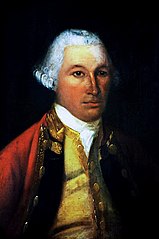| William Skinner | |
|---|---|
 about 1730 - unknown artist | |
| Born |
1700 St. Kitts |
| Died |
December 25, 1780 Greenwich |
| Nationality | British |
| Education | Paris and Vienna |
| Known for | Military Engineer |
Lieutenant-General William Skinner (1700 – 25 December 1780) was Chief Engineer of Great Britain. He was well known for his work on the fortifications of Minorca and Gibraltar although he considered his work on Fort George to be his "monument"
Life[]
Skinner was born in St. Kitts in 1700. Before he was an adult he lost his father, Thomas, and his mother, Elizabeth, and he was adopted by his aunt, Mrs Lambert. She remarried Captain Talbot Edwards who was the chief engineer in Barbados and the Leeward Islands. He was educated in Paris and Vienna[1] and was trained by his adopted father as his father was promoted to be the second engineer of Great Britain. When his father died on 22 April 1719 Skinner inherited not only the plans and maps of his adopted father but also those of Sir Martin Beckman and Sir William Beckman. In less than a month of his father dying Skinner was recognised as a practitioner engineer on 11 May 1719.[2]
In 1720 he was in Devonport working for Colonel Christian Lilly. In 1722 he was helping with fortifying Minorca and in 1724 he started his association with Gibraltar. He first helped Captain Jonas Moore with a survey of the peninsula which stood him in good stead for the 1727 Thirteenth Siege of Gibraltar where he was rewarded with additional pay for his achievements.[1] He was promoted steadily serving eventually as Director of engineering in Gibraltar.[2]
In 1746 he was sent to Scotland where the government intended to increase the fortifications now that the Jacobite Rebellion had been ended. In 1751, he began work on Fort George which cost over 100,000 pounds and was made to Skinner's design.[2] Skinner was to refer to the fort as his "monument" and would manage every detail which John Adam oversaw as the main contractor.
James O'Hara, 2nd Baron Tyrawley became Governor of Gibraltar in 1756[3] and set about improving the fortifications. These changes came under the notice and criticism of Lord George Sackville and Skinner wrote a report describing their inefficiency and arbitrariness. The two of them attended the House of Commons in 1758 where O'Hara harangued Skinner who took the anger in good humour.[4] There appears to have been no long term damage as O'Hara was given the rank of field marshal in 1763.[3]
Skinner died in Greenwich still working on Christmas Day 1780. His widow, Margaret, and his granddaughter both received exceptional annuities as there was some regret that Skinner had not been as well as he might have been. Despite spending huge sums his personal wealth at his death was a single house and a £500 annuity. Skinner’s son was drowned in 1861 but his grandson, William Campbell Skinner was a successful American engineer.[1]
References[]
| Wikimedia Commons has media related to William Skinner (Engineer). |
- ↑ 1.0 1.1 1.2 Skempton, A W (2002). Biographical Dictionary of Civil Engineers1500-1830. Thomas Telford. p. 617. http://books.google.co.uk/books?id=jeOMfpYMOtYC&.
- ↑ 2.0 2.1 2.2 William Skinner, DNB, accessed 31 January 2013
- ↑ 3.0 3.1 Stuart Handley, ‘O'Hara, James, second Baron Tyrawley and Baron Kilmaine (1681/2–1773)’, Oxford Dictionary of National Biography, Oxford University Press, 2004; online edn, Jan 2008 accessed 2 Feb 2013
- ↑ Paul Latcham, ‘Skinner, William (1699/1700–1780)’, Oxford Dictionary of National Biography, Oxford University Press, 2004; online edn, Jan 2008 accessed 1 Feb 2013
The original article can be found at William Skinner (engineer) and the edit history here.